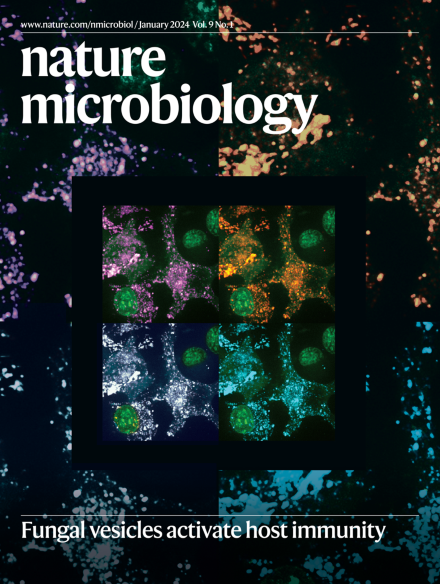arf4介导的细胞内转运作为广谱抗病毒靶点
IF 20.5
1区 生物学
Q1 MICROBIOLOGY
引用次数: 0
摘要
参与调节病毒子代细胞囊泡运输的宿主因子可能是潜在的抗病毒药物靶点。adp核糖基化因子(ARFs)是GTP结合后调节细胞内囊泡运输的GTP酶。本研究表明,ARF4基因缺失可抑制寨卡病毒(ZIKV)、甲型流感病毒(IAV)和SARS-CoV-2等多种致病性RNA病毒的感染。病毒感染导致ARF4激活,病毒生产在与活性ARF4互补而不是与失活突变体互补时恢复。从机制上讲,ARF4缺失破坏了病毒子代进入高尔基体复合体的易位,并将它们重定向到溶酶体降解,从而阻止病毒释放。更重要的是,靶向ARF4的肽通过抑制ARF4的激活,对小鼠的ZIKV和IAV攻击显示出治疗效果。我们的发现强调了ARF4在病毒感染中的作用及其作为广谱抗病毒靶点的潜力。本文章由计算机程序翻译,如有差异,请以英文原文为准。


ARF4-mediated intracellular transport as a broad-spectrum antiviral target
Host factors that are involved in modulating cellular vesicular trafficking of virus progeny could be potential antiviral drug targets. ADP-ribosylation factors (ARFs) are GTPases that regulate intracellular vesicular transport upon GTP binding. Here we demonstrate that genetic depletion of ARF4 suppresses viral infection by multiple pathogenic RNA viruses including Zika virus (ZIKV), influenza A virus (IAV) and SARS-CoV-2. Viral infection leads to ARF4 activation and virus production is rescued upon complementation with active ARF4, but not with inactive mutants. Mechanistically, ARF4 deletion disrupts translocation of virus progeny into the Golgi complex and redirects them for lysosomal degradation, thereby blocking virus release. More importantly, peptides targeting ARF4 show therapeutic efficacy against ZIKV and IAV challenge in mice by inhibiting ARF4 activation. Our findings highlight the role of ARF4 during viral infection and its potential as a broad-spectrum antiviral target for further development. ARF4 GTPase activity is needed for vesicular trafficking for multiple RNA viruses. Blocking ARF4 using specific peptides redirects viral progeny to lysosomal degradation and decreases influenza and Zika virus infection in mice.
求助全文
通过发布文献求助,成功后即可免费获取论文全文。
去求助
来源期刊

Nature Microbiology
Immunology and Microbiology-Microbiology
CiteScore
44.40
自引率
1.10%
发文量
226
期刊介绍:
Nature Microbiology aims to cover a comprehensive range of topics related to microorganisms. This includes:
Evolution: The journal is interested in exploring the evolutionary aspects of microorganisms. This may include research on their genetic diversity, adaptation, and speciation over time.
Physiology and cell biology: Nature Microbiology seeks to understand the functions and characteristics of microorganisms at the cellular and physiological levels. This may involve studying their metabolism, growth patterns, and cellular processes.
Interactions: The journal focuses on the interactions microorganisms have with each other, as well as their interactions with hosts or the environment. This encompasses investigations into microbial communities, symbiotic relationships, and microbial responses to different environments.
Societal significance: Nature Microbiology recognizes the societal impact of microorganisms and welcomes studies that explore their practical applications. This may include research on microbial diseases, biotechnology, or environmental remediation.
In summary, Nature Microbiology is interested in research related to the evolution, physiology and cell biology of microorganisms, their interactions, and their societal relevance.
 求助内容:
求助内容: 应助结果提醒方式:
应助结果提醒方式:


